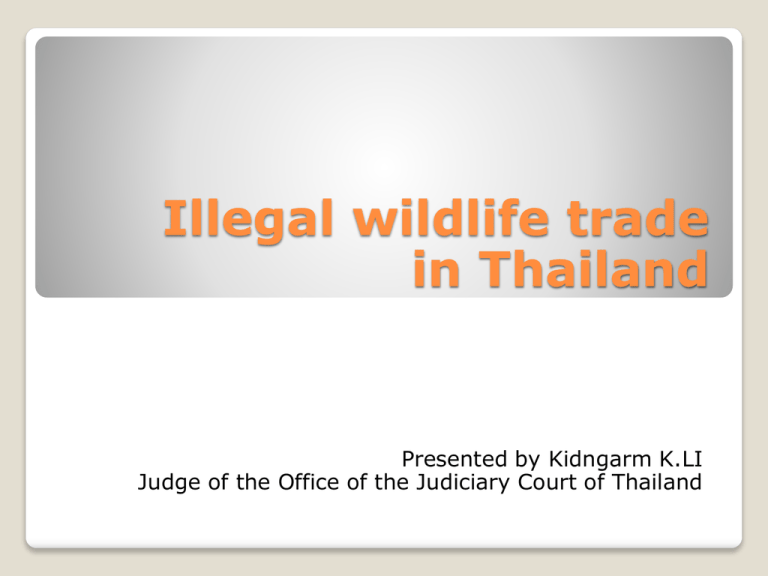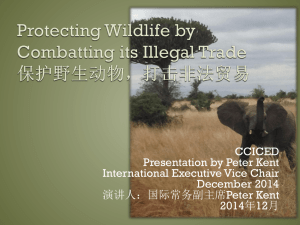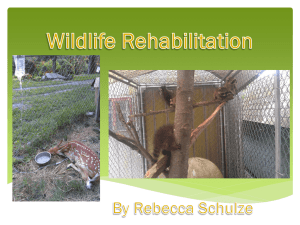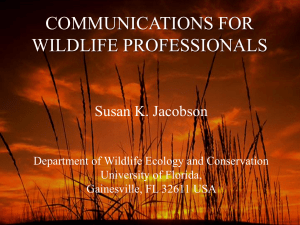PPTX
advertisement

Illegal wildlife trade in Thailand Presented by Kidngarm K.LI Judge of the Office of the Judiciary Court of Thailand The overview of the wildlife trade situation in Thailand Situation -7th Economic and Social development plan (1992-1996): to maintain economic growth and achieve sustainable development Legal instrument and Government effort in handling with the illegal wildlife trade type of animal number (piece) Turtle 8,597 bird 6,128 crocodile 3,543 snake 2,990 ivory 515 tiger 12 elephant 1 others 5,585 carcasses 1,589 Wild Animals Reservation and Protection Act 26 December 1960 (B.E. 2504) The Wildlife Reservation and Protection Act 1992 (B.E. 2535) Legal instrument was adopted on 19 February 1992 Government effort For Wildlife Preservation Wildlife Preservation Created by Royal Decree 44 Areas account for about 19,880,837 rais Wildlife Sanctuaries • Created by Royal Decree • 54 Sanctuaries covering 2,671,050 rais Wildlife Checks points • 49 Stop checks covering all exits from the countries Wildlife Breeding Stations • 18 station nationwide • To accommodate abandon wildlife animals Wildlife Preservation Promotion Unit • 18 units nationwide • To disseminate information to youngsters and public to create an understanding about preserving wildlife Wildlife research stations • 3 stations across the country • To study wildlife in their natural habitat The causes of the decline of wildlife in Thailand Actions Done Because of Lack of Knowledge High reward influenced crime Use of Chemicals and Pesticides Illegal poaching Encroachment on Forest Areas To be analyzed? Prevention Legal Enforcement (1)Low penalties prescribed by law if compared to rich rewards as it enacted since 1992 (2)Sentences may vary between regions because each region may vary from each other and defendant’s circumstances (3)Few cases appealed to the Supreme Court so there is not too strong sign to show people of how seriousness the crime is. (4)The understanding and experience of the prosecution about environmental case handling. (5)Limitation in Court Procedure : we categorize wildlife offences as criminal cases which plaintiff has a duty to proof guilty. (7) Gap of law and a limited number of enforcement officer In order to reduce the opportunity to do the offences Make it more difficult, more risky and less rewarding (1) Maximum penalties applicable to wildlife trade in Thailand under The Wildlife Reservation and Protection Act 1992 Charges Imprisonment Max. Financial Penalty Max Trade and trafficking offences 40,000 4 years Possession of species 40,000 4 years Hunt or attempt to hunt 40,000 4 years Harms endangered species 10,000 1 year Move without permission in written 5,000 - (2)-(3)Judicial Sanction Some sentences might slightly vary from region to region because each region differentiate from each other and it has to take into account the defendant’s circumstances. Besides, judges are independent in trial and adjudication, they have the discretion to consider relevant factors before sentencing without any interference. However such sentences are within the law prescribed. It should be noted that the effort of the Supreme Court in developing the sentencing guideline will be a tool for judges to exercise their discretions consistent nationwide. Nevertheless, not many cases were appealed to the SC and almost of them asking to suspend sentences. The establishment of Green Bench in all levels of court helps to create capacity building of judges in handling environmental cases. The Court of Justice also provide training to judges in environmental knowledge and adjudication. Statistic of the crime against wildlife appeal to the Supreme Court in the past 6 years Series 1 30 25 20 15 Series 1 10 5 0 2006 2007 2008 2009 2010 2011 (4)The understanding and experience of the prosecutor in environmental case Particular mention to the preparation of cases To ensure the relevant factors in relation to the gravity of the offence, defendant’s circumstances Scientific knowledge to legal matters such as DNA,Specimen Identification and expert witness (5) The limitation of Court Procedure Wildlife offence was categorized a criminal case which the plaintiff has a duty to prove the defendant’s guilty. We use criminal procedure law which was not designed for environmental law offences. Fortunately, we are in the process of drafting environmental case procedures which will use inquisitorial system. (6) Gap of law and lack of enforcement officer The Act licensing people to own wildlife and carcasses in some cases Limited numbers of enforcement officer who know forensic and can identify wildlife types So the offender will conceal or hide the prohibited wildlife with a permitted ones This limited numbers caused the difficulty in illegal wildlife trade control • Through school and out of educate school, • Through texts, news, article • Ex: exhibitions, Joining movement activities• Providing information to official Prevention is better than cure Reflect the principles of CITES in domestic law & practice Education and training play an important role What we have done ! Development of effective sentencing guildeline Support awareness raising programme Recommendations Reduce the opportunity to do the offence by make it more risky and less rewarding Give priority to transnational wildlife crime Raise the maximum penalty especially financial penalty Support finance, training & resources for authorities Effective legal framework Promote public awareness Thank you for your kind attention !






